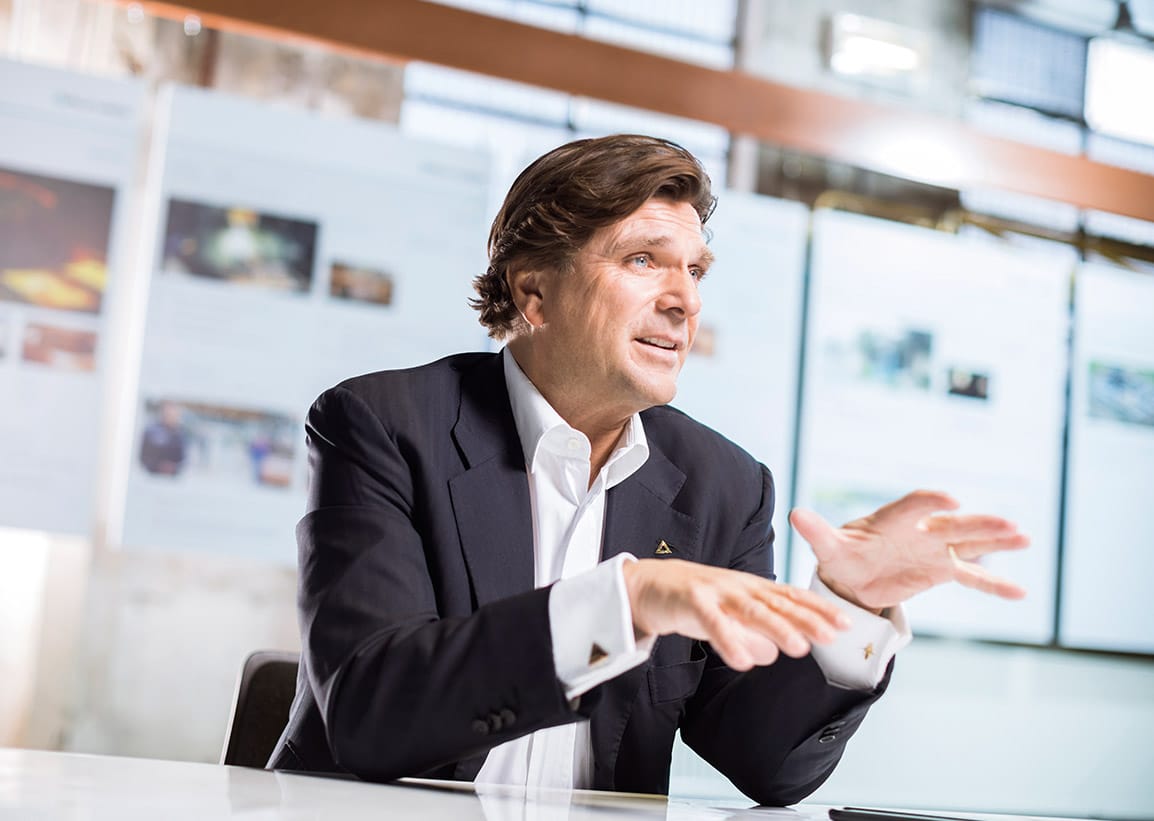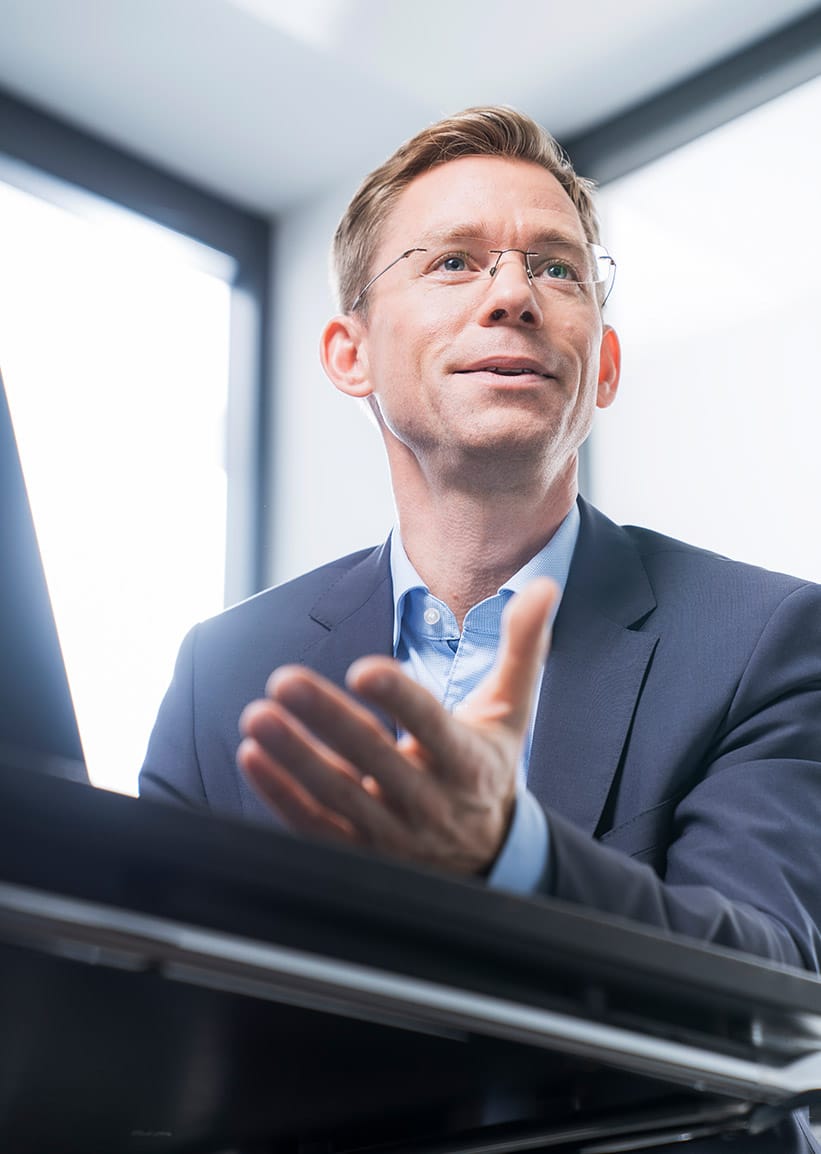Energy Efficiency
and Climate Protection
No copper without energy –
no energy without copper
Producing pure metals requires energy. In some cases, energy is already in our raw materials, for example, as sulfur in copper concentrate. The rest has to come from elsewhere. But energy isn’t free; it usually has to be produced at the expense of other raw materials, which often leads to CO2 emissions.

As an energy-intensive company, we are aware of our responsibility to handle valuable resources with special care. At the same time, the metals Aurubis produces make environmental developments like electric vehicles and electricity from renewables possible in the first place. Metals therefore make a considerable contribution to technologies that improve the CO2 balance.
Mr. Gehrckens, what are the biggest challenges at Aurubis when it comes to the topic of energy?
Ulf Gehrckens (UG): Without a doubt, legal regulations are often at the top of the agenda. The list of issues is broad and extends from CO2 cost relief and the renewable energy levy to grid charges. As a production company located in Europe and the US and employing almost 6,700 people, we follow the discussions on energy and climate issues. We track them at the political level in both Berlin and Brussels.
From an energy policy perspective, is it beneficial that you are so strongly represented in Europe?
UG: We don’t think about the situation in that way. We produce in Europe first and foremost. Our key sales markets are here and we are committed to this location.
Nevertheless, our main product – copper cathodes – is a globally traded commodity, the price of which is fixed on the metal exchanges. This price is guided by the law of supply and demand. This means that we can’t pass on higher energy costs that might be specific to the region to our customers through the product price. If our production costs in Germany increase disproportionately due to artificially established levies related to the energy transition, this weakens our competitive position compared to the rest of the world. We have to deal with this.
And how?
UG: We want to steadily become more energy-efficient while maintaining our high environmental protection standards, which is why we invest in large and small energy efficiency and environmental projects.
Aurubis’ smelters are among the cleanest in the world, with the lowest emissions to the environment compared to our competitors. That doesn’t just happen. We have invested over € 560 million in environmental protection since 2000. Moreover, we use modern, energy-efficient plant technology at all of our production sites and across all of our business processes.
Wherever possible, we also establish energy cycles to boost our efficiency. For instance, at the Lünen site we introduced a highly efficient process to generate electricity from waste heat and to use it for internal process heat.
The truth is, the more steps that have already been taken in energy efficiency, the more challenging it is to achieve additional optimizations.
Do you also use electricity from renewable energies?
UG: Generally speaking, we’d like to. Unfortunately, we are faced with the challenge that the use of these energies is affected by fluctuations in the energy supply. Our production processes require a constant energy supply, due in part to our energy efficiency measures.
We are working on initiatives to utilize renewable energies, however. One of these is the NEW 4.0 project. The idea of this nationwide project in Germany is to make the electricity feed-in from renewables more flexible so as to be able to react to fluctuating availability.
We’re planning an electrode steam boiler for this purpose, which will help us draw crucial steam from electricity, reducing our gas consumption and thus improving our CO2 balance. We will enhance our flexibility with respect to input materials at the same time.
Are there areas where Aurubis is an energy producer?
UG: We are taking a close look at all types of waste heat from our processes. Many of them are already used to supply heat and process steam, and in some cases to produce electricity internally. In Hamburg, we obtain 87 % of our process steam needs from waste heat. But we see more potential in this area.
We sometimes produce excess energy that we can’t use effectively ourselves. One example is the Industrial Heat project, which is close to my heart. This project involves extracting heat that we otherwise wouldn’t be able to fully use and making it available to the community.
We therefore prevent 20,000 t of CO2 per year. For a comparison, this is equivalent to the emissions of about 10,000 mid-range cars driving 12,000 km per year. And we have the potential to extract three times that amount of heat. By replacing other energy sources, we could prevent a total of 140,000 t of CO2 emissions each year. This is equivalent to the level that Hamburg industry established as a reduction target in a voluntary agreement. To leverage this potential, it would be helpful if carbon certificates were allocated under the EU emissions trading system for these kinds of CO2 reductions that are achieved outside of the plant.
Facts about the industrial heat project
Long pipelines
The pipeline connection from the heat source to HafenCity East is about 3.7 km long.

Hamburg’s Köhlbrand Bridge is nearly the same length.
Providing heat
The heat volume of 160 million kWh can supply a total of 8,000 four-person households for about a year.

The total available potential could cover 25,000 households.
Protecting the climate
The industrial heat project prevents 20,000 t of CO2. This is equivalent to the emissions of 10,000 mid-range cars driving 12,000 km per year.

If the full potential is utilized, CO2 emissions could even be reduced by about 140,000 t.
Conserving water
The adjustment to the acid cooling facility saves 12 million m3 of cooling water and Elbe River water annually.

This is equivalent to the volumeof around 4,800 Olympic-size swimming pools.
Mr. Hein, what do you find exciting about the industrial heat project?
Christian Hein (CH): The great thing is that everyone benefits from it. The residents of HafenCity East are supplied with sustainable heat, the city receives a contribution to its climate goals, and we direct our excess process heat to a meaningful purpose.
We are also a business, of course. The investment of roughly € 20 million has to pay off accordingly – and it does.
How does the heat get to HafenCity?
CH: It is formed in a sub-process of copper production: The sulfur in the copper concentrates is processed as sulfur dioxide and then converted into sulfuric acid in what we refer to as the contact acid plant. We transfer the heat formed in an exothermic chemical reaction from our plant in Hamburg to the energy service company enercity via a new, nearly 4-km-long pipeline. In turn, this company supplies HafenCity East with the heat.

And how exactly does this prevent CO2?
CH: From the start, the Industrial Heat that forms is nearly free of CO2. We can use about 25 % of the heat for internal purposes. About half of the more than 20,000 t of CO2 per year is prevented because we use less natural gas to produce steam. The other half comes from beyond the plant boundaries, specifically from the supply of external heat that replaces the conventional fuels used to generate district heating. On top of this, we save 12 million m3 of cooling water from the Elbe River each year.
What makes the project special from a technical perspective?
CH: Usually, Industrial Heat is kept at its original temperature and processed via heat exchangers. We go one step further: Our sulfuric acid process is adjusted to run at a much higher temperature – 117 instead of 65 °C, making the heat ideal for internal and external heating purposes. All without the use of fossil fuels and thus without CO2 emissions.
How was the project received outside of the company?
CH: It was remarkable. In its size and complexity, the Industrial Heat project is unique in Germany. This is evident in the interest shown by those inside and outside of Aurubis.
The German Energy Agency, dena, awarded the project two prizes: one for being one of ten examples of Flagships of Energy-Efficient Waste Heat Use, as well as the Energy Efficiency Award in the category Energy Transition 2.0. The Hamburg Renewable Energies Cluster also gave the project the German Renewables Award in the category Project of the Year 2018. For me personally, the industrial heat example is the ideal symbiosis of ecological responsibility and entrepreneurship – to the benefit of many.
